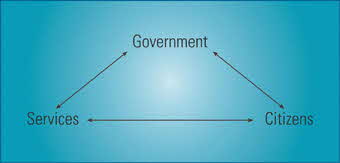Book Review: Public Services at the Crossroads
ETHOS Issue 04, Apr 2008

With a pool of increasingly educated citizens, a knowledge-savvy workforce and highly competitive market forces, many governments are feeling the pressure to continually improve the quality of their public services. This phenomenon is not felt in Singapore alone. The contributors to Public Services at the Crossroads, a report published by the noted UK-based Institute for Public Policy Research (IPPR), have also observed the same phenomenon in the UK. They argue that the design and delivery of public services should no longer be a prescriptive blueprint devised by the government independently, but should instead depend on the relationship between the government, services and citizens (Figure 1).
The demands placed on public services will continue to rise, as society becomes more educated and the problems it faces become more complex and broad-ranging.
The challenge to government is to balance high aspirations for public services against the risk of establishing unrealistic expectations, while also maintaining the trust and support of the public service workforce. For instance, can major improvements to public services take place without losing the support of incumbent staff, some of whom may have to be laid off or reassigned? The low levels of staff morale and confidence in management experienced by some public agencies in the UK point to the implications of an unbalanced approach to reform.
FIGURE 1. A MODEL OF CO-PRODUCTION
(Source: Public Services at the Crossroads, p52)

CITIZEN SATISFACTION—A PRIMARY GOAL OF PUBLIC SERVICES?
As the mindset shifts towards getting the relationship between government, services and citizens right, the desired outcomes of public services would need to be re-evaluated. Should customer satisfaction be the target and the means by which the civil service measures its success and allocates resources? According to the report’s authors, this appears intuitively appropriate: if citizens are not satisfied with public services, they would naturally withdraw their support from public services, lose trust in the civil servants who administer them, and reject the politicians who advocate them. Satisfaction with services gives voice to citizens, helps to redress the failings of unresponsive service agents, exposes policy decision-makers to public scrutiny, and may turn the spotlight on neglected services that are valued by citizens.
However, the heterogeneity of citizens’ expectations (“value pluralism”) means that few would share the same subjective interpretation of happiness or satisfaction. Besides, resource scarcity and environmental constraints mean that the civil service cannot fully satisfy those who adjust their preferences to ever higher levels of consumptions with little or no regard to constraints. Healthcare is a good example of a service type where such behaviour is observed in many countries.
Where should we draw the line between meeting the demands of citizens and being an efficient and effective government?
By the same token, the report concludes that satisfaction or happiness maximisation cannot be the basis for measuring the success of public services and allocating resources. Where should we draw the line between meeting the demands of citizens and being an efficient and effective government? Perhaps we may concur with Public Services at the Crossroads, that procedural justice (making and implementing decisions according to fair processes with respect to consistency, bias suppression, accuracy, correctability, representativeness and ethicality1) and distributive justice (what is just or right with respect to the allocation of benefits and burdens) must take precedence.
MISSING THE TARGETS IN PERFORMANCE MANAGEMENT
In the last decade, much public service reform has focused on adopting “top-down”, market-derived performance management mechanisms such as targets, incentives, regulation and intervention. In the UK, this “target-oriented” approach appears to have led to a number of unintended behaviours (outlined in Table 1). The drive to define the quality and efficiency of public services through performance targets may also have been at the expense of establishing useful norms and long-term outcomes for citizen behaviour in relation to public services—in terms of constructive feedback and dialogue, for example.
TABLE 1. PERFORMANCE, TARGETS AND THEIR POTENTIALLY PERVERSE SIDE EFFECTS

(Source: Public Services at the Crossroads, p36)
PUBLISHING PUBLIC SERVICE PERFORMANCE
In spite of the negative notions and side-effects that could be brought about by adopting a “top-down” performance management style, the report is right to point out that performance targets will continue to play an important role in the design and delivery of public services. The rule of thumb is not to rely excessively on management by targets but to ensure that any performance target set should clearly indicate the key public objectives in each instance.
The report’s authors further advocate that government departments should publish their performance data in a bid to stimulate improvements to service quality through public accountability and ‘peer-pressure’, especially where quasi-markets operate. They cited an example where there is little performance impact on a hospital if its performance data is shared internally and privately, whereas publication of this data had tremendous positive effects, motivated by a concern for the hospital’s public image. By the same note, the authors believe the same can be applied to the public service. They are not alone in this approach: government departments in Canada and US already publish their public service performance data online to inform their citizens.
It is clear that with higher service expectations and greater general IT literacy the public will become more demanding of information about their public services, and be more able to access and interpret that information. Already, some private sector organisations (such as Dr Foster, an independent commercial provider of healthcare information http://www.drfoster.co.uk) have emerged to play an intermediary role in relation to public service information.
The public will become more demanding of information about their public services, and be more able to access and interpret that information.
PUBLIC SERVICE WORKFORCE—ADMINISTRATORS OF PUBLIC SERVICES
In spite of increased resources and priority accorded to public services, the report found the UK public service workforce to persist in a state of disillusion and dissatisfaction. According to an MORI survey,2 public sector employees had less confidence (about 10% lower) in their management compared to private sector employees on assessments of trust, confidence and view of their vision. This was found to be particularly acute in the healthcare sector, where public servants cited lack of resources, the scale and speed of changes, and a lack of clarity about priorities as significant contributions to their grievances. Clearly this had a knock-on impact on general perception of public services, since public servants are often the sole channel of delivery for many inimitable services, as well as the representatives and spokespersons for their service areas and the public sector as a whole.
CONCLUSION
Public Services at the Crossroads highlights the difficulties of managing citizens’ expectations of public services, the importance of the public sector workforce as a determinant of both performance and perception of the public service as a whole. In the UK experience, public service reform initiatives seem geared towards finding an effective but often elusive balance between policy objectives, service provision and citizen expectations. If executed well and in the right spirit, the report asserts that efforts to improve service governance should help to strengthen trust (clarity of reform objectives, availability of public services performance to the public, and more citizen engagement) in government. If managed badly, delicate but critical changes, necessary to bring a nation to the next level of development, may falter or even fail.
NOTES
- Deutsch, Morton, “Justice and Conflict”, in The Handbook of Conflict Resolution: Theory and Practice, 2nd ed., eds. Deutsch, Morton, et al (California: Jossey-Bass, 2000).
- Truss, C., et al, Working life: employee attitudes and engagement. Research report (London: Chartered Institute of Personnel Development, 2006).

